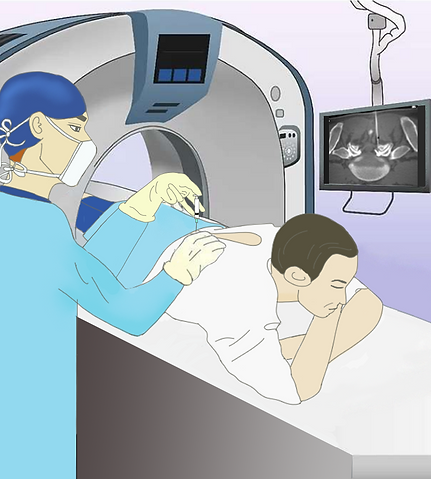Suite 407, San Clinic, Sydney Adventist Hospital, 185 Fox Valley Road, Wahroonga 2076
Tel: 02-9480-8728
What is an Epidural Injection and a Foraminal (nerve root) Injection?
The epidural space is the fat space between the sac containing the nerves and the outer bony canal. At each level, the nerve that leaves the spinal canal will traverse this fat space, which continues to wrap around the nerve as the nerve exit the spinal column through the keyholes (foramens) at each level.
Disc disease (rupture, degeneration, bulging), as well as narrowing of the spinal canal and exit foramens (due to spinal degeneration), can cause back pain, which sometimes radiates down the leg.
Injection of corticosteroid and long-acting local anaesthetic agent can counteract inflammation and soft tissue swelling.
Spinal injection is often used in conjunction with oral pain medications and physiotherapy to reduce the pain. Spinal surgery might eventually be needed in some patients.
Your referring doctor and the interventional radiologist will determine what would be best approach (Epidural or Foraminal), based on your symptoms, recent scans, and your anatomy. Therefore, it is important that you fill in the symptom survey form and bring along your recent imaging (or allow us to access on-line).


How do I prepare for an image guided injection?
As you will be lying on your stomach during the procedure and will be uncomfortable if your stomach is too full, you should limit food intake to a light meal only, up to 2 hours before the procedure.
You should also limit your fluid to sips of water only in the 2 hours prior to the procedure, and you should empty your bladder before you have the procedure.
Please wear comfortable clothes and shoes that are easy to remove and leave jewellery at home.
If you are taking any blood thinning medications, they may need to be stopped prior to the procedure. You will be given specific instructions about when to stop and restart the medication. These drugs are usually prescribed to prevent stroke or heart attack, so it is very important that you do not stop taking them without clear instruction by your doctor or us. Aspirin is usually not stopped.
You will need to have someone take you home, as you are not allowed to drive immediately after the procedure.
How is the injection done?
We use CT scan to precisely guide a skinny needle to the target site. You will need to lie still for about 10 to 15 minutes on your stomach. We will first perform a planning scan, then we will mark the entry site, and cleanse the skin with antiseptics. Local anaesthetic is used to numb the needle path. The skinny needle is then advanced to the target to inject.
What do I expect after the injection?
There could be transient increase in back and leg pain. Therefore, you will need to continue your usual pain medication for at least 24 hours. You should avoid strenuous activities for 2 days. If the pain is improving, you can gradually reduce your pain medication. Not everyone responds to the injection. If the pain persists, you will need to contact your referring doctor for advice on next step management.
You might feel dizzy when you get off the CT table. You might also feel numbness and weakness in the legs due to the transient anaesthetic effect on the nerve. Let us know and we will organise a bed for you to lie down. Rarely, you might have urinary incontinence if you cannot feel a full bladder.
Arm pain and weakness can be felt after cervical foraminal (neck nerve root) injection. On rare occasions, difficulty swallowing can be experienced. These are usually transient due to the anaesthetic effect.
Some patients might feel hot flushes and redness for a few days due to the corticosteroid. Diabetic patient will need to monitor blood sugar level.
Headache related to leaking of cerebral spinal fluid is rare.
Post procedure, you should lie down to rest, keep your hydration up, and take paracetamol.
What are the potential risks?
Allergy, haemorhage and infection are very rare complications. Direct injection into the nerve causing permanent damage is also very rare. Unintentional injection into an artery supplying spinal cord causing paraplegia is extremely rare.
How effective is the injection, how soon should I see the result and how long will it last?
If your pain is mainly due to inflammation and soft tissue swelling, then the injection can be very effective. It is less effective if your pain is due to compression from hard tissues like bony growth and scar tissues. Sometimes it is difficult to tell from your scans and your referring doctor wants you to try this minimally invasive option to see how much you can improve.
It might take a few days for the steroid effect to kick in.
How long the effectiveness last depends on whether the exacerbating factors are improved or eliminated. If your pain recurred after a period of improvement, discuss with us or your referring doctor to see if a repeat injection is appropriate.




